Highlights of the Chino 2010 Airshow

Once again, the Chino Airshow in Southern California demonstrated why it's consistently ranked as one of the top three warbird shows in the United States. This year was particularly good for formations, such as the P-38 Lightning, P-51D Mustang, and Supermarine Spitfire shown here. |

This was also an especially good year for Mustang fans, with at least seven different aircraft in the air, as well as formation aerobatics by The Horsemen, who swapped their usual F8F Bearcat steeds for Mustangs! |
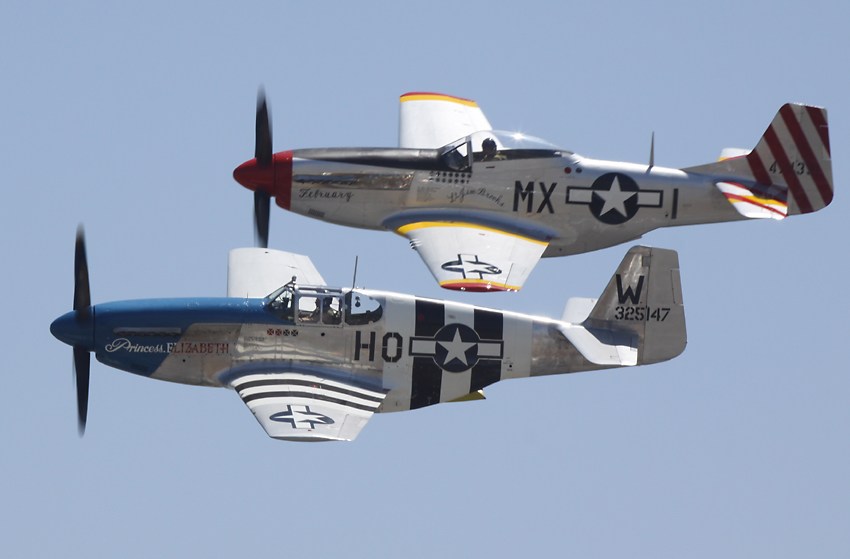
It was also a special treat to see not one but two early model P-51B Mustangs with a high back, rather than the usual low-cut back and teardrop canopy of the later P-51D model. Here's one of those P-51Bs in formation with a P-51D. As an added bonus there was even a flight by an A-36 Apache (also sometimes referred to as an A-36 Invader), the dive-bomber version of the Mustang which was used in North Africa and Asia before being retired in 1944. This was the first outing for this particular Apache, which had its first flight after restoration just a week before the show. It will be an unusual and welcome addition to the airshow circuit. |

The P-51D called "Hell-er Bust" showed another side of the Mustang, fitted out with bombs in its fighter-bomber role. United States Air Force P-51s continued to serve in this capacity during the Korean War until jet-powered MiG-15 fighters forced them to be withdrawn. |
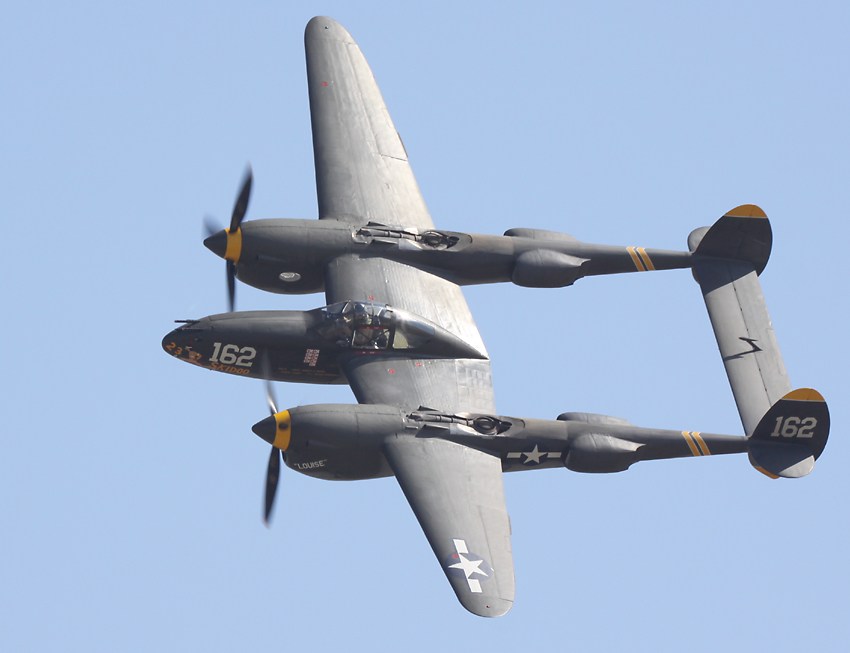
We were also lucky enough to have a pair of P-38 Lightnings on display, including this one called "23 Skidoo". America's top two wartime aces both flew P-38s in the Pacific. Dick Bong ended up with 40 victories and Tommy McGuire with 38. |
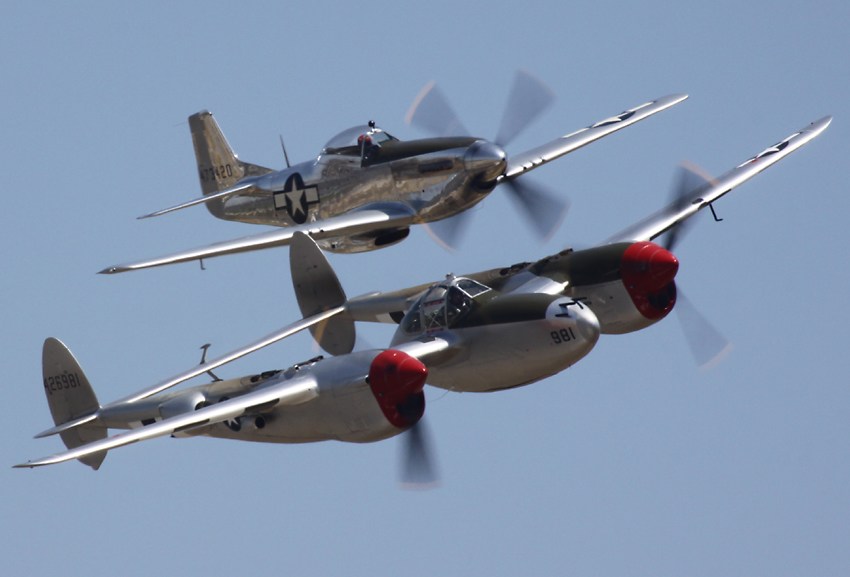
Here's the other P-38, in formation with a P-51 in its original aluminum finish. Early in the war, American aircraft used color schemes which were intended to camouflage the aircraft to some extent. However, by 1944 the Allies had air supremacy to such an extent that most aircraft were delivered unpainted, except for insignia and dark patches in front of the pilot, to reduce glare. |

The "shark's tooth" pattern on this P-40 Warhawk is one of the most famous pieces of World War Two nose art. Although widely believed to have been invented by the Flying Tiger squadrons fighting in China, it was actually first used on Royal Air Force P-40s in North Africa, copying similar artwork on German Bf 110 fighters. However, even this wasn't the first use of this motif on fighter aircraft - similar artwork was used as early as World War One. |

The P-40 was America's best fighter going into the war, but it was soon surpassed by better designs, such as this P-47 Thunderbolt. This is one of the early model P-47s, in fact it's the only surviving "razor back" Thunderbolt which is still flying. Later P-47s have the same type of "tear drop" or "bubble" canopy which was pioneered by the British on the Typhoon and Tempest fighters. The tear drop canopy provides much better rear vision, an important survival factor in combat. |
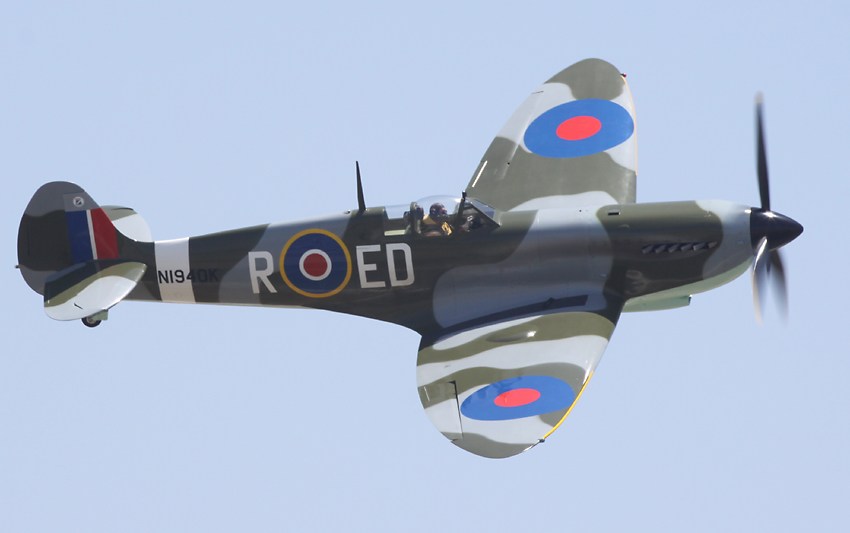
Before the adoption of the tear drop canopy, British fighters were often fitted with a rear-vision mirror, like the one you can (barely) see poking above the front of the curved "Malcolm hood" on this beautiful replica Spitfire. The Malcolm Hood was itself an attempt to give pilots a better all-around view than was possible with early canopies, which attempted to improve performance by extending into the airflow as little as possible. |
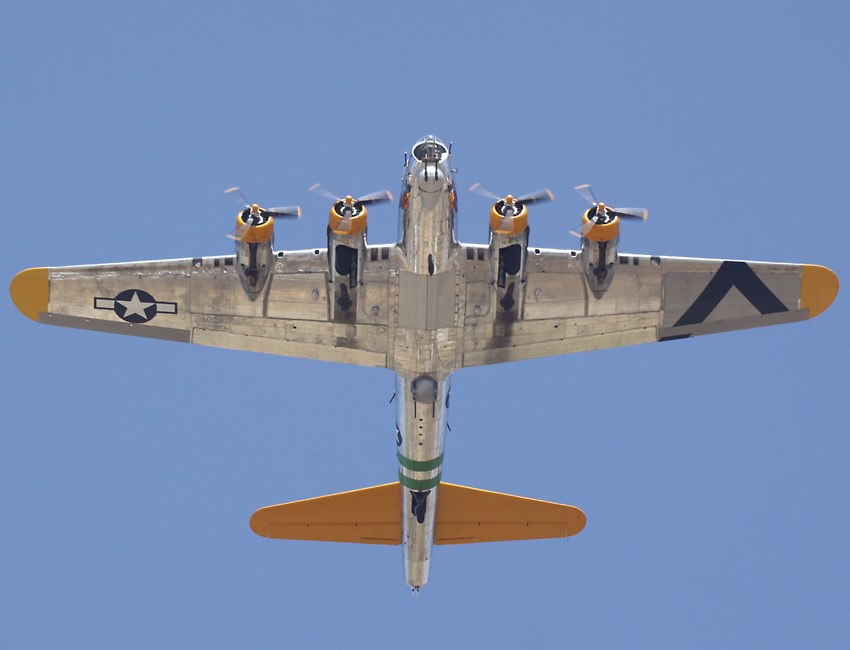
There were a few bombers at the show, too, like this B-17 Flying Fortress called "Fuddy Duddy". You don't get to see this sort of overhead pass at many shows, now the only thing we need is to have the bomb bay doors open! This shot does show off most of the Flying Fortress's defensive armament, ten 50 caliber machine guns visible, and another two in the top turret. |

A B-25 Mitchell bomber, but with a difference - it's marked in Russian Air Force colors. The Russians received over 860 B-25s under wartime "Lend-Lease" arrangements, and they kept them in operation long enough for them eventually to be assigned the NATO reporting name "Bank". The Russian Air Force Museum at Monino has several lend-lease aircraft, all clearly labeled, together with a Tu-4 "Bull", the reverse-engineered version of the B-29 Superfortress. The Russian B-25s were frequently operated from Monino during the war, so it's very appropriate to see one still there! |
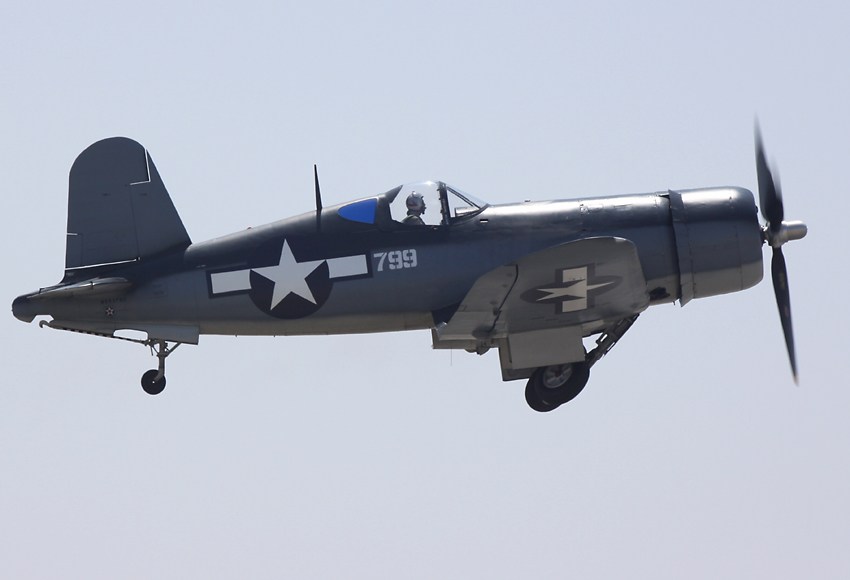
As well as air force types, the organizers of the show always put a good selection of naval aircraft into the air. A pair of F4U Corsairs flew, here's the one in US Navy colors taking off. The Navy delayed putting the Corsair into service on its carriers for a long time, because the extended nose made it very hard to see the carrier deck on approach. It was the British Fleet Air Arm which overcame the problem, by flying a curved approach rather than the usual straight-in approach. In spite of its slow start, the Corsair were still being manufactured until 1953, finally achieving the longest production run of any American piston-engined fighter. |
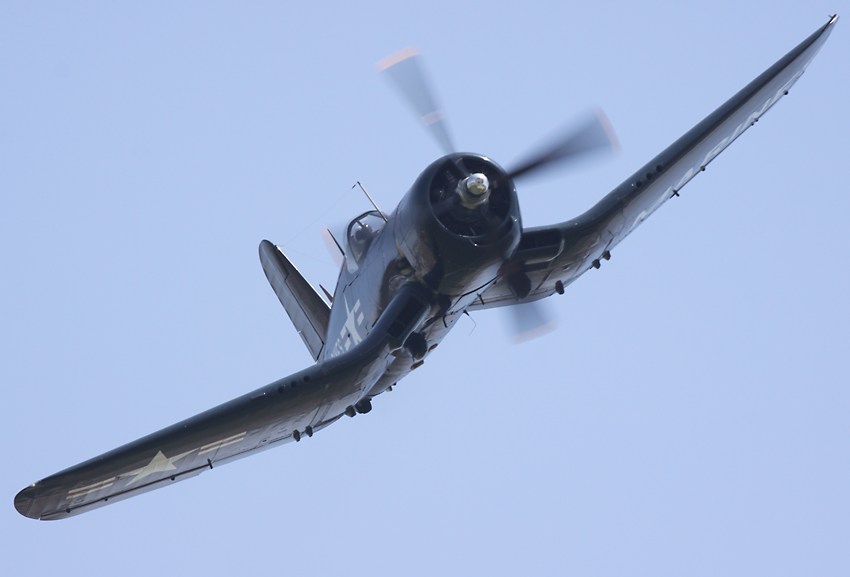
The US Marine Corp did operate Corsairs like this one, flying from land bases. The US Navy and Marines adopted several other changes the British made with their Corsairs - fitting the curved Malcolm Hood which you can see on both the F4Us at this year's show, and raising the seat by seven inches to improve visibility. |

Here are both of the Corsairs together. Apart from the US Navy and Marines, and the British FAA, New Zealand was the only other operator of the Corsair during World War Two, buying 424 to equip 13 squadrons, a surprisingly high number for such a small country. |

The Hellcat was replaced by the F8F Bearcat, another aircraft by the same manufacturer, the legendary Grumman Aircraft corporation. Grumman made most of the US Navy's fighter aircraft during this period, starting with the FF-1 biplane of the 1930s, through to the Wildcat, Hellcat, Tigercat and Bearcat monoplanes of World War Two, and then onto jets like the Panther, Cougar and Tiger, and finally culminating with the F-14 Tomcat, which many people still consider the best naval fighter aircraft of all time. |
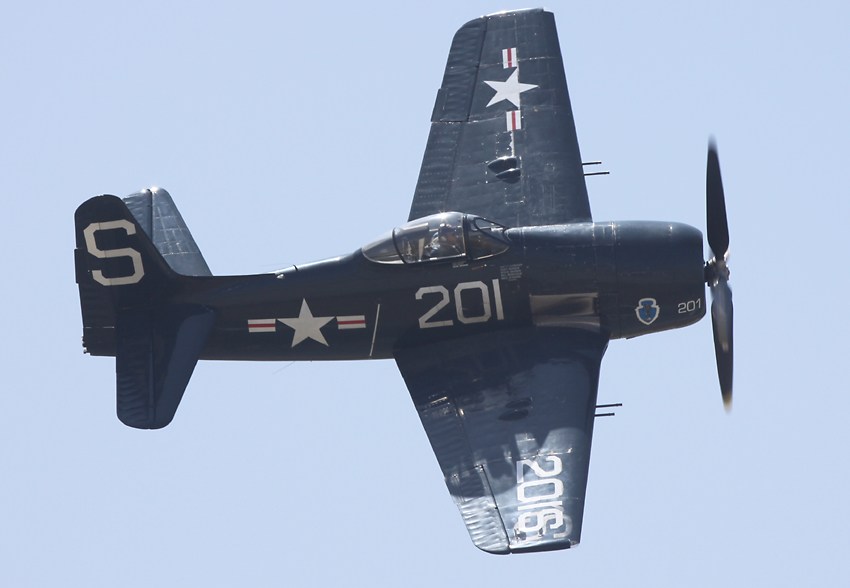
The Bearcat was Grumman's last propeller-driven fighter. It used the same Pratt and Whitney R2800 engine as the Hellcat, but the Bearcat's lighter weight made it 50 miles per hour faster, and able to climb 30% faster. The Bearcat was the first plane flown by the Blue Angels display team, which the navy established in 1946. |
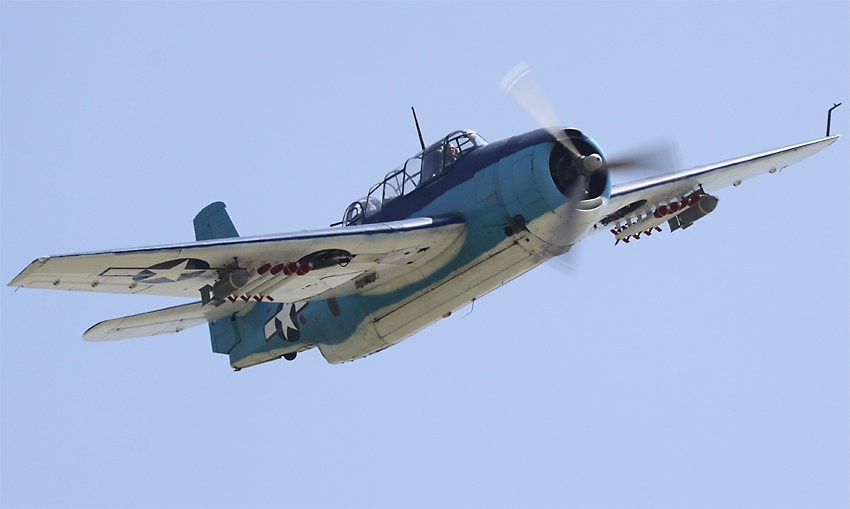
Here's another aircraft designed by Grumman, the Avenger torpedo bomber. The original designation of this plane was TBF Avenger, ("F" being the US navy's manufacturer code for Grumman), but since most of the production run was manufactured by the General Motors car company, most people know it as the TBM Avenger. The first outing of the Avenger was during the Battle of Midway. It was a very inauspicious beginning, with five of the six aircraft sent out being shot down, and the sixth returning in terrible condition. |

The Douglas Dauntless was a dive bomber which sank more Japanese shipping than any other aircraft, even though it was mostly replaced at the end of 1943 by the Helldiver. With two forward-firing 50 caliber machine guns, and one or two 30 caliber machine guns in a flexible mount in the rear cockpit, the Dauntless was sometimes used against other fighters. In spite of its slow speed, one Dauntless piloted by Stanley Vejtasa shot down two Zeroes in a single dogfight. New Zealand was the only other country which used them in combat, and this is in fact one of the planes which served with the Royal New Zealand Air Force. |
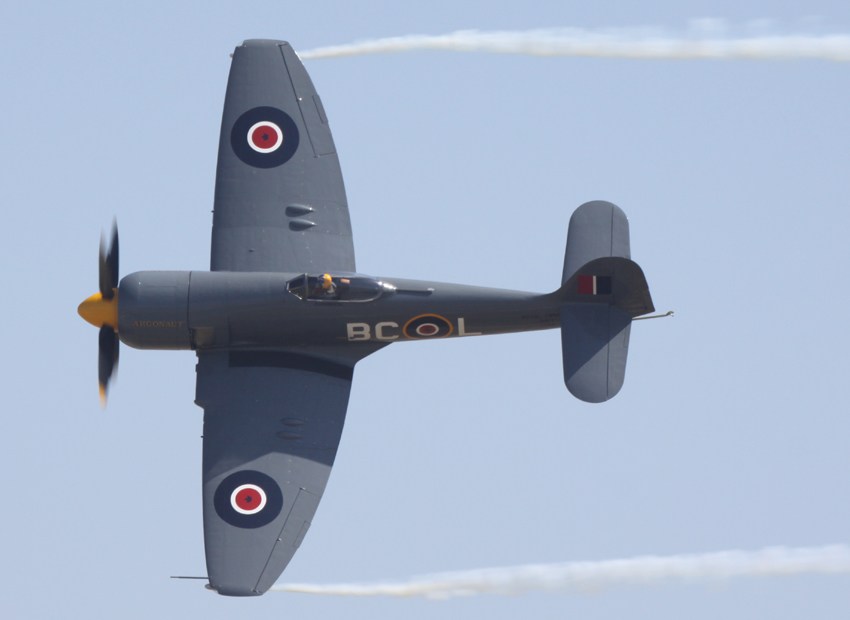
There were several other foreign naval fighter aircraft in the air, like this beautiful Sea Fury, which operated with the Royal Navy and the Royal Canadian Navy during World War Two. It was used by the military forces of many countries after the war, including the Cuban air force, which used them to wipe out the American aircraft supplied to Cuban exiles for the Bay of Pigs Invasion. The Sea Fury was the last propeller-driven fighter the Royal Navy operated, but it was by far the best, being one of the fastest propeller fighters of the war, which has made it popular to this day as an air racer. |
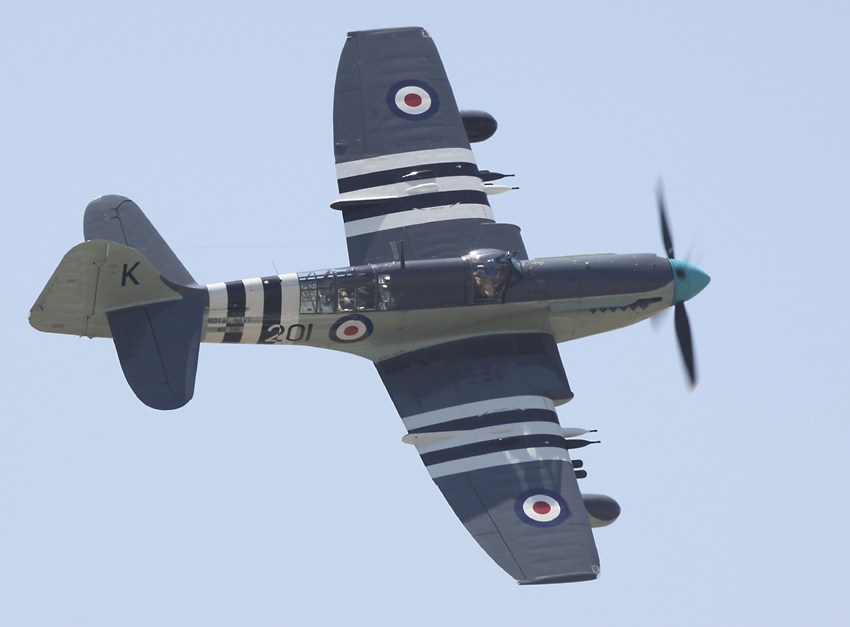
The Fairey Firefly was another British naval fighter, but because it had a second crew member in the back, its speed was far below that of the Sea Fury. Nevertheless, it was a very maneuverable plane, and it was used both in Europe and the Pacific, becoming the first British aircraft to fly over Tokyo. During the war, the Firefly was used both as a fighter and in a ground attack role. Its four 20mm cannon, eight 60 pound rockets and ability to carry two 1000 pound bombs meant that it packed a heavy punch. |
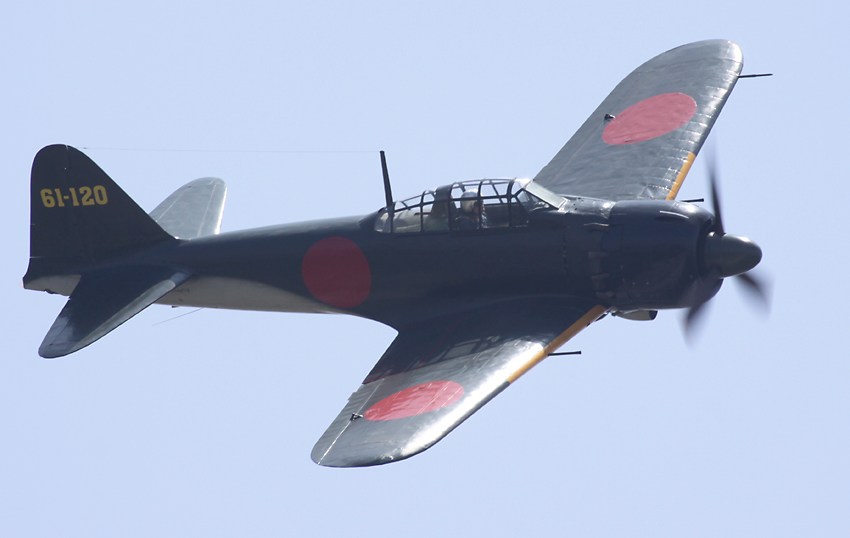
Chino is the only place in the world where you can see an authentic Mitsubishi Zero flying. There are a few complete Zeros in museums in different places, but the ones which are flying are either replicas (usually based on the T-6 Texan trainer) or, like the beautiful Camarillo Zero, have very few original Zero parts in their construction. |
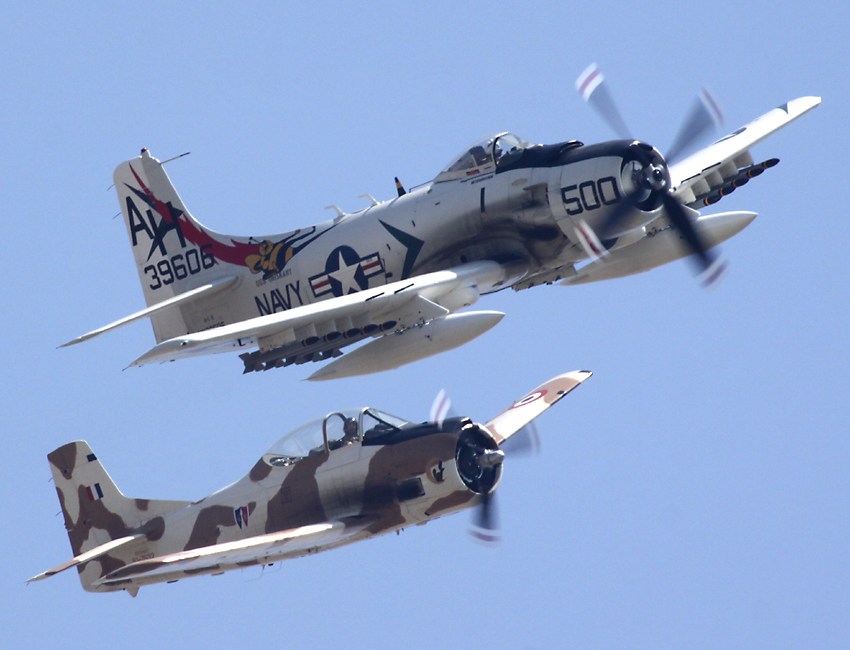
Bob Grondzik and his daughter Dana are the only father/daughter team on the airshow circuit in the USA. Here you can see Bob (aka "Skyraider Bob") flying his beautiful naval A-1H Skyraider, with Dana in a T-28 Trojan which has been modified to appear like a "Fennec" of the French Air Force. The Fennec is a type of desert fox, which is the meaning of the black symbol painted on the fuselage directly behind the propeller. The French were the first to outfit the T-28 with hardpoints for carrying weapons, either four 250 pound bombs, rocket launchers or machine gun pods. They were used against rebels in Algeria. The United States later adapted some of their own T-28s and used them in the ground attack role in Indo-China. |
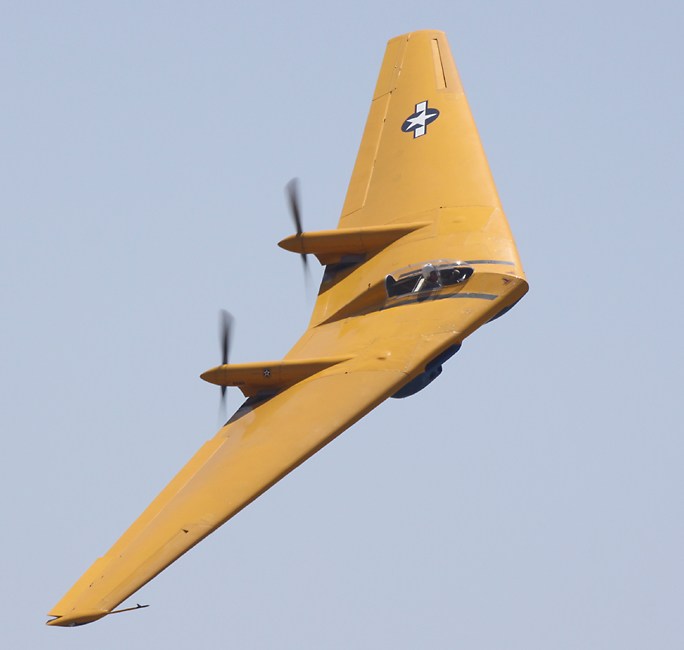
The Planes of Fame Air Museum at Chino has a very active restoration program, and they have many unique aircraft which can be seen nowhere else. This Northrop N9MB Flying Wing was a one-third scale test aircraft created during the development of the XB-35 and YB-35 flying wing bombers during the 1940s. The XB-35 and YB-35 both flew, but neither went into production, and it wasn't until 1989 that the Northrop B-2 Spirit stealth bomber proved that the basic concept was sound. |
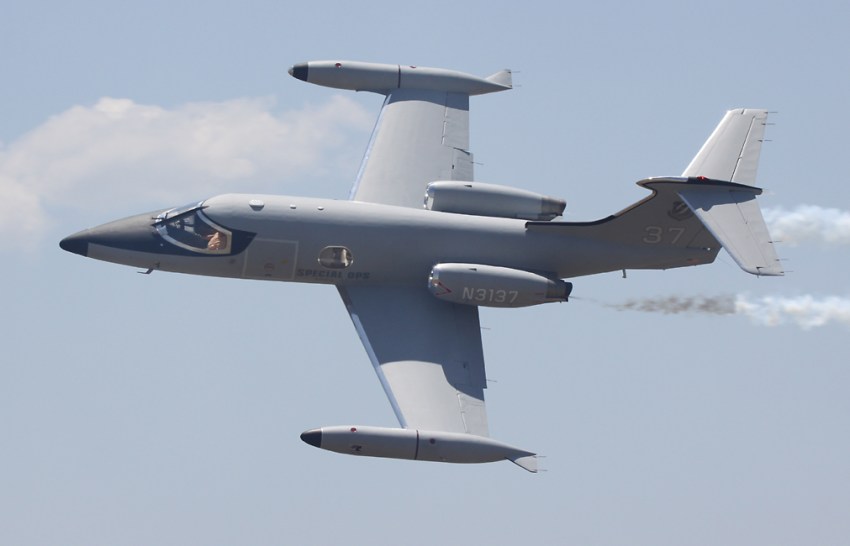
Clay Lacy did an extended display, complete with smoke generators, in his Lear model 24 executive jet, fancifully painted in a "special ops" color scheme. It's said that he has more flight time in jets than anyone else on earth, over 50,000 hours worth, and as well as running his jet charter business he also does air-to-air photography for movies and airline commercials. |

Here's a Russian MiG-15 "Fagot" jet fighter, which entered service during the Korean War. There are several MiG-15s flying at airshows around the world, but this is one of the more interesting of them, because of its North Korean markings. |
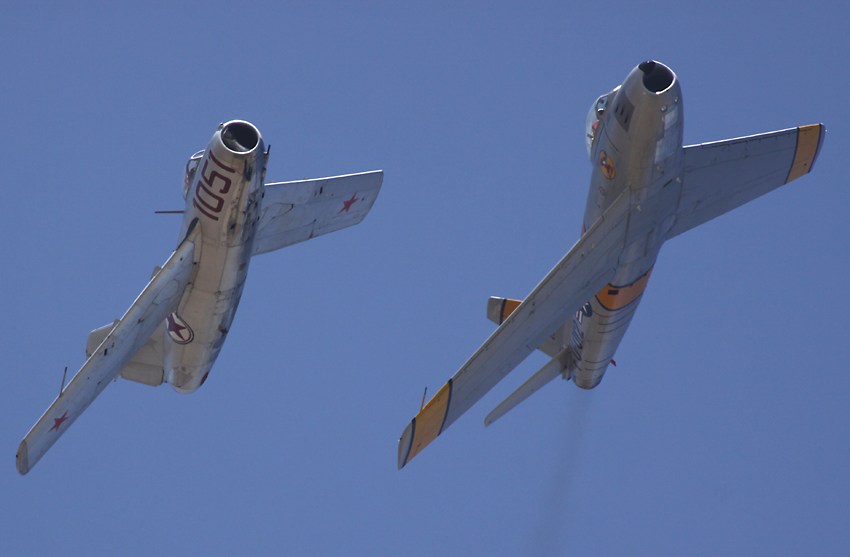
The folks at Chino often fly their MiG-15 in tight formation with their F-86 Sabre at airshows in the south-west. It's a very appropriate combination, since these two aircraft types were the main fighter combatants in the Korean War. Both planes are also used in movies, such as the first "Iron Man" film, which utilised them as stand-ins for the F-22 Raptors which tried to intercept Iron Man as he was flying. |

As well as the historic aircraft, Chino always offers something for people who like to see displays of modern military aircraft. One surprisingly popular recent addition to the repertoire is the C-17 Globemaster III. Although a display by a cargo plane might not seem very interesting, the C-17's ability to maneuver tightly and slowly right in front of the crowd has made it a great addition to the scene. |

Of course, people like to see fast-movers as well, this year the honors being done by the Viper West team flying their F-16 Fighting Falcon. Here we see their high-speed pass, complete with afterburners and a little vapor against a gorgeous dark blue California sky. |

Air Force "Heritage Flight" formations are a popular part of many airshows in the United States, but there aren't many shows which can put two P-38 Lightnings in the air with a P-51 Mustang and an F-16 Fighting Falcon! |
